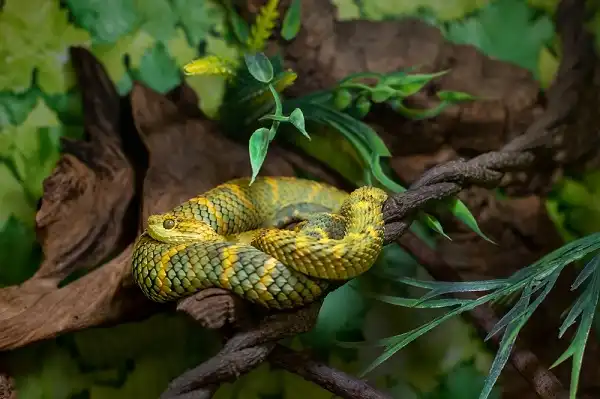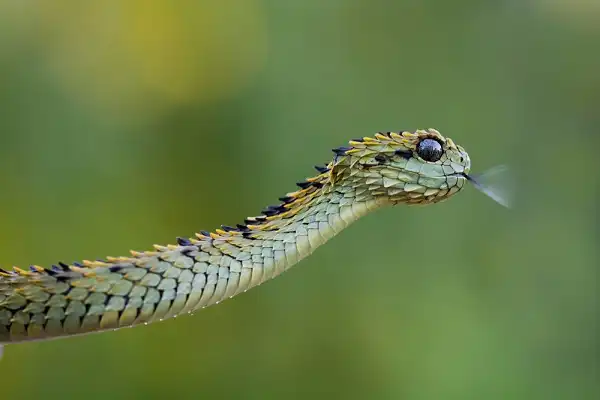The bush viper is a venomous snake found in sub-Saharan Africa. It gets its name from its habit of hiding in bushes, waiting to ambush its prey. Despite its size, the bush viper is one of the most dangerous snakes in Africa, thanks to its highly toxic venom. If you’re lucky enough to spot a bush viper in the wild, be sure to give it a wide berth!

Bush Viper Description
The bush viper has a short and stout body with a pointed head and large, robust scales. Its overall coloration is typically green or yellow-green, with flecks of red or orange on its back. It often has bands of black rings around its body, which may have white or yellow spots in the center. The belly is usually yellow or tan in hue. Bush vipers are usually active at night and during the day they can be found resting in trees or dense vegetation. They live mainly among lowland forests but can also be found in grasslands and savannas.
Bush Viper Habitat
The bush viper is a largely arboreal species, found in trees and dense vegetation from the savannas to the lowland forests of sub-Saharan Africa. They can be found in a variety of habitats, such as moist forest edges, rocky outcroppings, and coastal plains. They also live in some parts of North Africa and the Middle East. In general, bush vipers prefer warm climates with high humidity — they thrive in temperatures ranging from 70 to 90 degrees Fahrenheit (21-32 Celsius). Bush Vipers have developed several adaptations that help them survive in their environment. For instance, their bright coloration helps them blend into their surroundings when they remain still or relatively inactive. This coloration is also a form of camouflage that helps deter potential predators.
Bush Viper Diet
The Bush Viper is an opportunistic hunter, and its diet tends to depend on the prey that is most easily available. It typically feeds on small mammals, like mice and shrews, as well as birds, lizards, and frogs. They may even consume other snakes, such as non-venomous species or smaller venomous snakes. In addition, they also feed on insects like beetles and grasshoppers. Bush Vipers are also known to exhibit cannibalistic feeding behaviors if food is scarce or hard to come by in their environment – which has been observed in captive individuals when competing for limited resources. This behavior is thought to be linked with nutrition needs or stress levels in the individual snake rather than a predatory instinct.

Bush Viper Size
The Bush Viper is a medium-sized species of a venomous snake, typically measuring between 2 and 4 feet in length. However, some individuals have been known to grow up to 5 or even 6 feet long! They typically weigh between 1-2 pounds and have a slim, graceful build that allows them to easily navigate the branches of trees and dense vegetation. The bodies of Bush Vipers are quite thin compared to other species of snakes – this helps them squeeze into tight spaces or maneuver through branches if needed. They also possess enlarged head scales which help protect their heads from potential attacks by predators or prey alike.
Bush Viper Lifespan
The Bush Viper is a species of venomous snake that typically has a lifespan of 8 to 12 years in the wild. However, with proper care and nutrition, they can live up to 20 years in captivity. In the wild, the average lifespan of the bush viper is affected by various factors such as predation, disease, food availability, and environmental conditions. These snakes reach maturity at around three years old and are capable of reproducing twice a year. The female will typically lay between 2-6 eggs per clutch which then incubate for approximately two months before hatching.
Once born, bush vipers usually stay near their mother until they are ready to venture out on their own and begin hunting for prey. Bush vipers are also known to exhibit an interesting adaptation known as ‘reversed sexual dimorphism’. This means that males tend to be longer than females – an adaptation that may give them an advantage in mating competitions or when attempting to locate prey.
Bush Viper Behavior
Bush Vipers are primarily solitary creatures, spending their days hidden among leaves and branches and emerging at night to hunt for prey. They have a unique adaptation that allows them to climb vertical surfaces – giving them an advantage when attempting to hide in dense foliage. When threatened, Bush Vipers will coil up into an S-shape and produce a loud hissing noise as a warning sign to potential attackers. This type of defensive behavior is known as ‘thrashing’ – with the snake flicking its tail rapidly back and forth while hissing loudly in order to appear more intimidating. In terms of behavior, Bush Vipers are typically quite secretive and rarely seen out in the open – preferring instead to remain hidden away until nightfall when they emerge to hunt for food.

Bush Viper Speed
Bush Vipers are capable of moving at surprisingly high speeds for a venomous snake, and this is largely due to their slender body and muscular legs. While they tend to move relatively slowly when traveling on the ground, they can accelerate rapidly when threatened or chasing prey. In terms of speed, bush vipers have been recorded reaching up to 1 meter per second – approximately equivalent to 2.2 miles per hour! This may not seem particular fast when compared to other snakes such as king cobras or pythons whose top speeds exceed 7 m/s; however, it is important to remember that bush vipers possess much smaller bodies than these other species – meaning that in order for them to reach such speeds, they must expend greater amounts of energy.
Bush Viper Hunting
Bush Viper hunting is a unique and thrilling experience. These snake species are highly active at the night and use their superior vision, smell, and agility to locate their prey. Bush Vipers use an ambush-style hunting technique where they sit still while waiting for potential prey to pass by. Once they detect something, they strike out rapidly with lightning speed and have been known to leap up to 3 feet off the ground in order to catch their target. They normally hunt alone, but sometimes form temporary hunting parties when seeking larger prey such as deer or other small mammals. Bush Vipers are also equipped with chemical sensors located on their tongue which can detect even the faintest whiff of pheromones released by potential prey – a trait that has enabled this species of snake to become one of the most successful hunters among all venomous snakes today!

Conclusion
Bush Vipers are incredible snakes that have evolved unique adaptations to help them survive in the wild. With powerful muscles supporting their slender frames and adaptations such as sidewinding, they can move quickly and efficiently while expending minimal energy in the process. Additionally, they possess an array of sensory abilities including thermoreceptors and chemical sensors which allow them to detect potential prey more easily – making them one of the most successful hunters among all venomous snakes today. All these amazing features combined make Bush Vipers a truly remarkable species!
Frequently Asked Question


